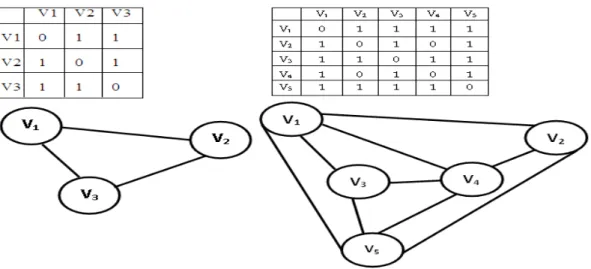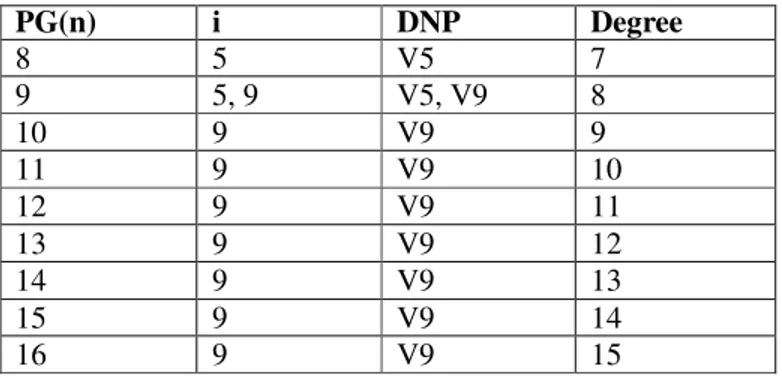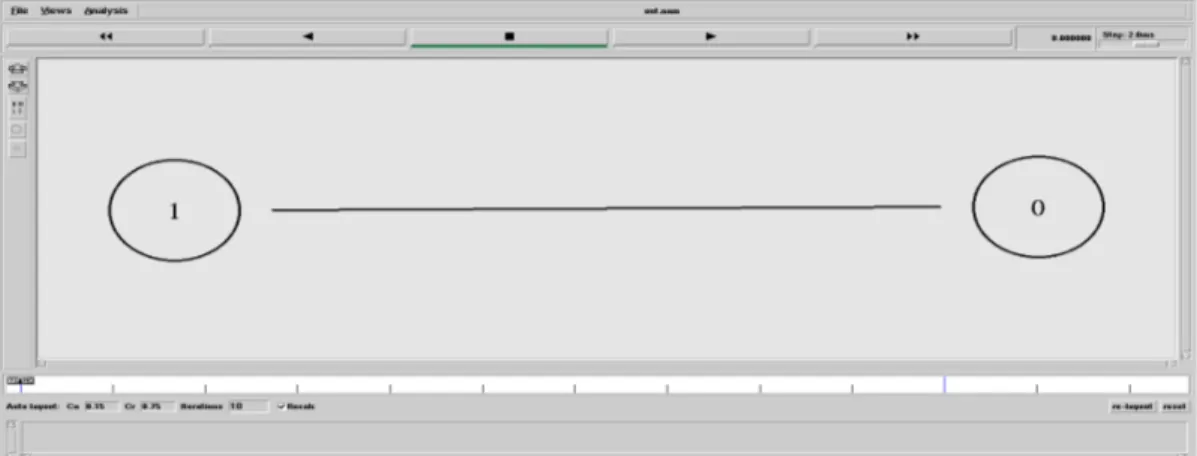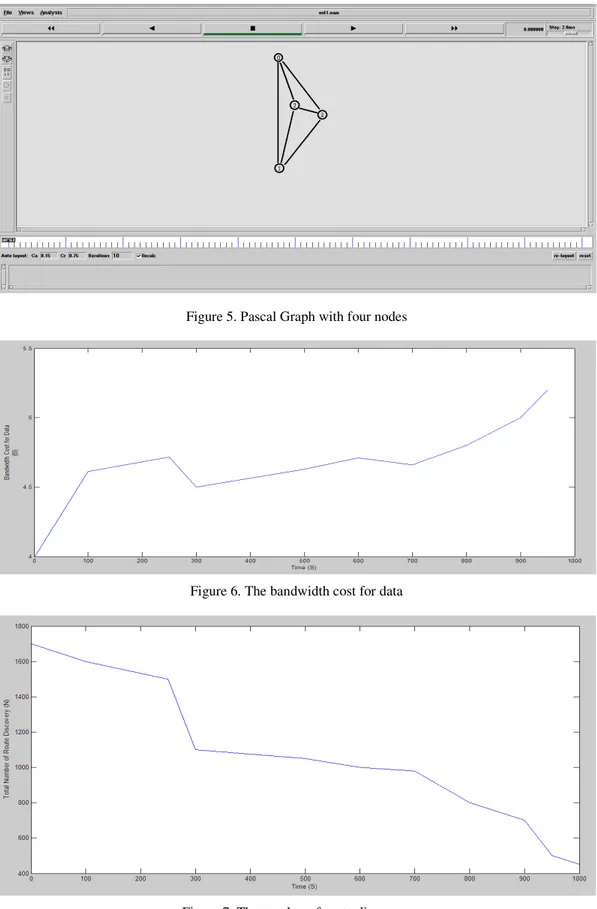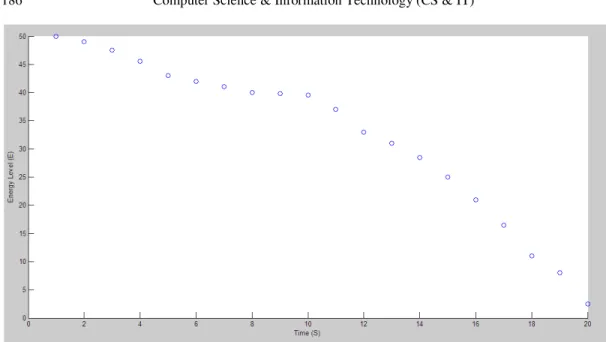Rupak Bhattacharyya et al. (Eds) : ACER 2013,
pp. 175–189, 2013. © CS & IT-CSCP 2013 DOI : 10.5121/csit.2013.3217
Deepali Panwar
1and Subhrendu Guha Neogi
21Department of Computer Science and Engineering, Sir Padampat Singhania
University, Udaipur, Rajasthan, India 1
deepali.panwar@spsu.ac.in 2subhrendu.neogi@spsu.ac.in
A
BSTRACTDevelopment of energy efficient Wireless Sensor Network (WSN) routing protocol is nowadays main area of interest amongst researchers. This research is an effort in designing energy efficient Wireless Sensor Network (WSN) routing protocol under certain parameters consideration. Research report discusses various existing WSN routing protocols and propose a new WSN energy efficient routing protocol. Results show a significant improvement in life cycle of the nodes and enhancement in energy efficiency of WSN. In this paper, an attempt has been made to design a wireless sensor network involving the extraction of Pascal Graph features. The standard task involves designing a suitable topology using Pascal Graph. As per the definition of interconnection network it is equivalent that a suitable graph can represent the different computer network topologies very efficiently. Different characteristics of Pascal Graph Topology has been discovered and used in network topology design. Since Pascal Graph gives better result in terms of finding the dependable and reliable nodes in topology, it has been considered for network analysis. Moreover, we propose a methodology that involves the Pascal Graph Topology for wireless sensor network which can analyse and represent the network and help in routing.
K
EYWORDSWSN, Energy efficient, WSN routing protocol, Pascal Matrix and Pascal Graph
1.
I
NTRODUCTIONWSN consist of hundreds or thousands of small, cheap, battery-driven, spread-out nodes bearing a wireless modem to accomplish a monitoring or control task jointly. Although a profusion of routing mechanisms has been proposed for other wireless and mobile networks, the unique characteristics of WSN suggest that WSN demand a specific solution. To have a clear and precise focus on future research in WSN routing, the characteristics of WSN that have a strong impact on routing must be identified. Then a set of criteria is defined against which the existing routing protocols from ad hoc, sensor, and WSN can be evaluated and performance metrics identified. This will serve as the basis for deriving the key design features for routing in wireless sensor networks. An important concern is the network lifetime: as nodes run out of power, the connectivity decreases and the network can finally be partitioned and become dysfunctional [2-3]. Routing in WSNs is a very challenging problem due to the inherent characteristics which differentiate such networks from other wireless networks such as ad hoc networks and cellular networks [2-4]. In recent years, many algorithms have been proposed for the routing issue in WSNs. The minimum energy routing problem has been addressed [5-6]. The minimum total energy routing approaches in these papers are to minimize the total consumed energy. However, if all traffic is routed through the minimum energy path to the destination, the nodes along that path will run out of batteries quickly rending other nodes useless due to the network partition even if they do have available energy. Instead of trying to minimize the total consumed energy on the path, the objective is to maintain the connected network as long as possible. If sensor nodes consume energy more equitably, they continue to provide connectivity for longer, and the network lifetime increases [5-10]. A number of potential solutions have been proposed, including full end-to-end wireless access and ad-hoc networks. Industry has divergent views on some parameters based upon their experience of designing wireless sensor network which includes network components, properties of sensor nodes, degree of mobility, traffic pattern, energy efficiency of sensor nodes, routing between sensor nodes. The Wireless Sensor Network has been designed using different data structures such as graph, tree, linked list and other techniques like neuro-fuzzy, swarm intelligence etc. A sufficient representation has been so far made to design different computer network topologies using appropriate graph models. Graphs have huge contributions towards the performance improvement factor of a network. Some major contributors are de-Bruijn, Hypercube, Mesh and Pascal. As per the definition of interconnection network it is equivalent that a suitable graph can represent the physical and logical layout very efficiently. However, deploying these networks requires the installation of a large amount of wireless sensor devices. The initial investment costs for deployment and the difficulty of deployment in some environment settings have prevented the widespread realization of such access networks. As sensor networks have specific requirements on energy saving, data-oriented communication, and inter-connection between non-IP and IP, therefore sensor network dedicated routing protocols may be required, for energy efficient routing scheme. In WSN there are the routing protocols that minimize the used energy, extending subsequently the life span of the WSN [8-9, 11-12]. Energy awareness is an essential in routing protocol design issue. Depending on the network structure, routing in WSNs can be divided into:
a) Flat-based routing
b) Hierarchical-based routing c) Location-based routing
Depending on the protocol operation, routing in WSNs can be divided into:
Against this backdrop, the present study first attempts to make a comparative analysis of different graph topologies on the identified features of wireless sensor network and propose an energy efficient routing algorithm in wireless sensor network designed using Pascal graph topology. In this paper, we revisit this main idea is to design a suitable algorithm to create topology in wireless sensor network using Pascal Graph. The article is organized as follows. Section 2 briefly reviews different techniques and Section 3 deals with a precise description of our methodology. Section 4 is devoted to design issues and section 5 emphasizes on discussion of the study. Finally, Section 6 concludes the paper and gives suggestions for future work.
2.
L
ITERATURER
EVIEWenergy more equitably, they continue to provide connectivity for longer, and the network lifetime increases [11-13].
3.
M
ETHODOLOGYThe proposed methodology involved in this study entails following 2 phases:
3.1. Phase I - Deep investigation
For achieving reliable results and excellent efficiency of the problem solution, further in depth literature review has been done. The literature review is done in section 2.
3.2. Phase II - Designing & Development
In this phase, solution of the identified problem has been developed for onward analysis, efficiency and reliability measures during modelling and simulation. The proposed solution has been reconsidered based on the analysis of the results of simulations for further improvement of the solution. Section 4 illustrates the design principles and discussed in section 5.
4.
D
ESIGNING WITHP
ASCALG
RAPH4.1. Pascal Graph and method for designing topology
The following example shows the Pascal Matrix of PM (3) and PM (5) and the corresponding Pascal Graph in figure 1.
Figure 1. Pascal Graph with 3 and 5 nodes
metrics. The cost of a link in model i) is the Euclidean distance of the link, in model ii) the distance is raised to a predefined power. The remaining graph Gtc should be sparse, that is, the number of links should be in the order of the number of nodes. It follows that from the similarity analysis point of view, the intersection graph GO(K,E) of H defines the co-word graph having as many edges as there are non-null values in a similarity matrix.
4.2. Properties of Pascal Graph and generation method
There are certain pragmatic properties that make Pascal graph a better choice for a computer network topology over many others [40]. Some of those properties are given below:
PG(n) is a sub-graph of PG(n+1) ∀ n ≥ 1 [37].
All Pascal Graph PG(i) for i ≤ 1 ≤ 7 are planner; all Pascal Graph of higher order are non-planner [44].
Ιn the Pascal Graph, Vertex V1 is adjacent to all other vertices and VertexVi is adjacent
to Vi+1 for i ≥ 1 [40].
In the Pascal Graph, two even numbered vertices are never connected and adjacent to each other.
More than one node except V1 in Pascal Graph has special properties in terms of connectivity.
If k=2n +1, n is a positive integer and then Vkis adjacent to all Vi [44].
All Pascal Graph of order≥ 3 are 2-connected [37].
There are at least two edge disjoint path of length≤ 2 between any two distinct vertices
in PG(n), 3 ≤ n [44].
If Vi is adjacent to Vj, where j is even and |i-j|>1, then i is odd and Vi is adjacent to Vj-1
[44].
Let det(PM(n)) refer to the determinant of the Pascal matrix of order n. Then,
Det(PM(n)) is even, for alln ≥ 3 and det(PM(n)) = 0, for all evenn ≥ 4 [44].
Ιn the Pascal Graph, V1 is considered to be most dependable and reliable node, the properties of Vk have few similar properties of V1 for k=2n +1 where n is a positive integer.
The following steps will generate a Pascal Graph:
Step 1: Enter p number of vertices to form a graph G = (V;E). Step 2: Initialized LT[p,0] = 1;
Step 3: From the lower left triangle [LT(p,p)] by adding the number directly above and to the left with the number directly above and to the right to find the new value. If either the number to the right or left is not present, substitute a zero to its place [44].
Step 4: From the upper right triangle [UT(p,p)] using the same manner the generic Pascal Matrix is formed.
Step 5: Convert the lower left and upper right triangle into binary values by using modulo approach.
Step 6: From the final adjacency matrix [PM(p,p)] of with LT(p,p) and UT(p,p). Step 7: Stop.
called most dependable and reliable node in terms of routing and path optimization in the graph. To satiate our claim and to rationalize the whole thing we have used very simplistic approach [40, 41].
The explanation with some suitable example is given below.
Case 1: m = 2(log m)
Case 2: m π 2[log m]
Case N: m = 2[log m]+1
To establish the new property, we are supposed to generate the index i of DNP.
For Case 1: i = 2(log m) − 1 +1, where i φ 1
For Case 2: i = 2[log m] +1 where i φ 1
For Case N: i = 2[log m] − 1 +1 and i = 2[log m] +1, where i φ 1
The formation of Pascal graph depends on DNP and its properties. The graph has mesh network but minimum number of connectivity as per requirements. There are atleast two paths available between nodes and V1 can provide connectivity with minimum hop count between any nodes. The similar property can be found with the nodes have same functionality with V1 as per the formation of graph.
The design of Pascal Graph from Pascal Matrix showed the existence of Dependable nodes of Pascal Graph (DNP) along with V1 where there is a full connectivity with other nodes. The graphs are not planner in the case of PG(n) with N>7 but the connectivity is not as complex as we have more than two dependable nodes in some cases. The Table 1 gives the list of DNP in case of Pascal Graph where n > 7.
Table 1. List of DNP
PG(n) i DNP Degree
8 5 V5 7
9 5, 9 V5, V9 8
10 9 V9 9
11 9 V9 10
12 9 V9 11
13 9 V9 12
14 9 V9 13
15 9 V9 14
16 9 V9 15
5.
D
ISCUSSIONgraphs and do not include any identical triplet of the labels of two vertices and the edge direction between the vertices within each sub-graph [47].
Figure 2. Mesh-Pascal(a,b,n)-Graph
From the Figure 2, we can find that it is forming a well-connected graph compared to other graphs. Pascal graph is best among them in terms of diameter but it is worse in terms of maximum degree of a node and total number of edges. On the other hand, ring and mesh perform well in terms of maximum degree of a node and total number of edges, but they both perform poorly in terms of diameter of graph. The proposed graph gives a standard measurement in terms of degree, diameter and total number of edges. The only graph which comes close to it is hypercube graph. But the hypergraph fails measurably compared to the proposed graph model when we consider total number of edges, reliability of the network and expansion-contraction of the network. If we expand the hypercube from the dimension q to q+1, it would reconfigure 2q number of nodes (which increases exponentially). But the proposed model improved by adding nodes to PGN (Pascal Graph Network), so we have to reconfigure a few member of nodes to get a better network as in Mesh-Pascal Graph(ab,n), multiple path exists between two nodes and the network can be more reliable and fault tolerant for that reason.
consumption by the nodes which has higher connectivity is more and they are dependable nodes as well. So we considered the energy efficiency of dependable nodes and the performance also being demonstrated in time frame and it is one of the major issues in PGN that the energy consumption is higher in case of DNP and this can be one of the major factors of routing as well. The following figures illustrate the PGN and performance of the network designed in NS2 simulator.
Figure 3. Pascal Graph with two nodes
Figure 5. Pascal Graph with four nodes
Figure 6. The bandwidth cost for data
Figure 8. WSN node life and energy drain with respect to time after increasing hops
6.
C
ONCLUSION ANDF
UTURES
COPE OFS
TUDYIn this paper we have proposed new WSN routing algorithm by using Pascal Graph. Many new routing and MAC layer protocols and different techniques have been proposed for WSN network and most of them trying to resolve the resource constrained for unattended wireless sensor environment, The majority of all the protocols mainly Concentrate on energy efficiency of sensor nodes, however sensor application have very important role specially in critical applications like the defence and health where the accuracy and guaranteed data transfer timely is an important issue. In the same way with some more specific sensor applications where the data type is mainly image and movie is supposed to be transfer, we required more accuracy and guarantee for timely data transfer. Hence transfer of data in such cases mainly requires QoS aware routing network management in order to ensure efficient usage of the sensor nodes. We already start working on a proposed and approved project from Deanship of scientific research, KFU, related to the QoS of WSN as it has a very key role for enhancing WSN efficiency and even its life, with that project we will focus on operational and architectural challenges of handling QoS routing traffic in sensor network and will propose a new mechanism for QoS based routing protocol to further enhance WSN life. On other hand, as we know that wireless sensor network (WSN) becomes more attractive area for the researchers now day, due to the wide range of its application areas and due to the distributed and deployment nature of these networks in remote areas, these networks are vulnerable to numerous security threats that can adversely affect their proper functioning. This problem is more critical if the network is deployed for some mission-critical applications such as in a tactical battlefield. Random failure of nodes is also very likely in real-life deployment scenarios.
A
CKNOWLEDGEMENTSR
EFERENCES[1] Jamal N. Al-Karaki, Ahmed E Kamal, (2004), "Routing Techniques in Wireless Sensor Network: A Survey", IEEE Wireless Communication, accessed at
http://www.ics.uci.edu/~dsm/ics280sensor/readings/networks/routing-survey.pdf on 1.1.2013. [2] I.F. Akyildiz, W. Su, Y. Sankarasubramaniam, and E. Cayirci, (2002), "A Survey on Sensor
Network", IEEE Communication Magazine, vol. 40, no.8, pp. 102 – 116.
[3] N. Bulusu, J. Heidemann, and D. Estrin, (2000), “GPS-less Low Cost Out Door Localization for Very Small Devices,” Tech. rep. 00729, Comp. Sci. Dept., USC, Vol. 7(5), pp. 28 – 34.
[4] Q. Cao, T. Abdelzaher, T. He, and R. Kravets, (2007), "Cluster-Based Forwarding for Reliable End-to-End Delivery in Wireless Sensor Networks", 6th IEEE International Conference on Computer Communications. IEEE , vol., no., pp. 1928-1936.
[5] Ettus, M., (1998), "System Capacity, Latency, and power consumption in multihop-routed SSCDMA wireless networks", Proc. of RAWCON'98, pp. 55-58.
[6] Rodoplu, V. and T. H. Meng, (1999), "Minimum energy Mobile wireless networks", IEEE JSAC, vol.17, no.8, pp. 1333-1344.
[7] Bhardwaj, M. and A. Chandrakasan, (2002), "Bounding the lifetime of sensor networks via optimal role, assignments", Proc. of the INFOCOM'02, pp. 1587-1596.
[8] Chang. J H., Tassiulas, L., (2000), "Energy conserving routing in wireless ad-hoc networks", INFOCOM, Nineteenth Annual Joint Conference of the IEEE Computer and Communications Societies Proceedings, IEEE , vol.1, no., pp.22-31.
[9] Chang, J. H. and L. Tassiulas, (2004), "Maximum lifetime routing in wireless sensor networks", IEEE/ACM Trans. on Networking, vol.12, no.4, pp. 609-619.
[10] Zussman, G. and A. Segall, (2003), "Energy efficient routing in Ad Hoc disaster recovery networks", Proc. of the INFOCOM'03, pp.682-691.
[11] A. K. Sadek, W. Su, and K. J. R. Liu, (2007), "Multi node cooperative communications in wireless networks," IEEE Trans. Signal Processing, vol. 55, no. 1, pp. 341-355, 2007.
[12] A. K. Sadek, Z. Han, and K. J. Ray Liu, (2006), "A distributed relay-assignment algorithm for cooperative communications in wireless networks," in Proc. IEEE International Conference on Communications (ICC), vol. 4, pp. 1592-1597.
[13] Subramanian, L., Katz, R.H., (2000), "An architecture for building self-configurable systems", in: Proceedings of IEEE/ACM Workshop on Mobile Ad Hoc Networking and Computing, pp. 63-72. [14] Ye,F., et al., (2002), "A two-tier data dissemination model for large scale wireless sensor networks",
in: Proceedings of the 8th annual international conference on Mobile computing and networking, pp. 148-159.
[15] Tilak, S., et al., (2002), "A taxonomy of wireless micro sensor network models, Mobile Computing and Communications", Review 6 (2), pp. 28–36.
[16] Sohrabi, K., et al., (2000), "Protocols for self-organization of awireless sensor network", IEEE Personal Communications 7(5), pp. 16–27.
[17] Heinzelman, W, Chandrakasan, A., Balakrishnan, H., (2000), "Energy-efficient communication protocol for wireless sensor networks", in: Proceeding of the Hawaii International Conference System Sciences, Hawaii, 8(8), pp. 929-942.
[18] Younis, M., Youssef, M., Arisha, K., (2002), "Energy-aware routing in cluster-based sensor networks," Modeling, Analysis and Simulation of Computer and Telecommunications Systems, 2002. MASCOTS 2002. Proceedings. 10th IEEE International Symposium on , vol., no., pp. 129- 136. [19] Manjeshwar A, Grawal DP. TEEN: A protocol for enhanced efficiency in wireless sensor networks.
Proceeding of the 15th Parallel and Distributed Processing Symp. San Francisco: IEEE Computer Society, 2001, pp. 2009-2015.
[20] Heinzelman, W., (2000), "Application specific protocol architectures for wireless networks", PhD Thesis, MIT, accessed at http://www.sigmobile.org/phd/2000/theses/heinzelman.pdf on 1.1.2013. [21] Katz, R. H., Kahn, J. M., Pister, K. S. J., (1999), "Next century challenges: mobile networking for
“Smart Dust” ", in: Proceedings of the 5th annual ACM/IEEE international conference on Mobile computing and networking, pp. 271-278.
[23] Estrin, D., et al., (1999), "Next century challenges: scalable coordination in sensor networks", in: Proceedings of the 5th annual ACM/IEEE international conference on Mobile computing and networking, pp. 263-270.
[24] Heinzelman, W., Kulik, J., Balakrishnan, H., (1999), "Adaptive protocols for information dissemination in wireless sensor networks", in: Proceedings of the 5th annual ACM/IEEE international conference on Mobile computing and networking, pp. 174-185.
[25] Lindsey, S., Raghavendra, C. S., (2002), "PEGASIS: Power-efficient gathering in sensor information systems," Aerospace Conference Proceedings, IEEE, vol.3, no., pp. 3-1125- 3-1130.
[26] Krishnamachari, B., Estrin, D., Wicker, S., (2002), "Modeling data centric routing in wireless sensor networks", in: Proceedings of IEEE INFOCOM, New York, pp 142.
[27] Braginsky, D., Estrin, D., (2002), "Rumor routing algorithm for sensor networks", in: Proceedings of the First Workshop on Sensor Networks and Applications (WSNA), Atlanta, GA., accessed at www.cs.wmich.edu/wsn/doc/rumor/Rumor.pdf on 1.1.2013.
[28] Schurgers, C., Srivastava, M. B., (2001), "Energy efficient routing in wireless sensor networks," Military Communications Conference, 2001. MILCOM, Communications for Network-Centric Operations: Creating the Information Force, IEEE, vol.1, no., pp. 357- 36.
[29] Akyildiz,I.F., et al., (2002), "Wireless sensor networks: a survey", Computer Networks 38 (4), 393– 422.
[30] Hedetniemi,S., Liestman,A., (1998), "A survey of gossiping and broadcasting in communication networks", Networks 18 (4), 319–349.
[31] Shah, R.C.; Rabaey, J.M., (2002), "Energy aware routing for low energy ad hoc sensor networks," Wireless Communications and Networking Conference, WCNC2002, IEEE, vol.1, no., pp. 350- 355. [32] Petrek. J., (2002), "A New Assignment Algorithm for Star Network Topology Design", In: 9th IEEE
International Conference on Electronics, Circuits and Systems ICECS 2002. Dubrovnik. Croatia, 15.-18.9.., pp. 789-792.
[33] Latha. S. & Srivastava., S. K., (2007), "On Some Aspects of Design of Cheapest Survivable Networks", IJCSNS International Journal of Computer Science and Network Security, VOL.7 No.11, pp. 210.
[34] Kamalesh., V. N, & Srivastava., S. K., (2009), "Topological Design of Minimum Cost Survivable Computer Communication Networks: Bipartite Graph Method", International Journal of Computer Science and Information Security, Vol. 3, No. 1, accessed at http://arxiv.org/pdf/0908.1033 on 1.1.2013.
[35] Berna. D., et al., (1995), "A Genetic Algorithm Approach to Optimal Topological Design of All Terminal Networks, Proceedings of the Artificial Neural Networks in Engineering Conference ANNIE`95, University of Missouri-Rolla, St. Louis, Missouri, USA, Nov.12-15, pp. 405-411. [36] Mason., L., et al., (2006), "Topological Design and Dimensioning of Agile All Photonic Networks",
accessed at http://www.tsp.ece.mcgill.ca/Networks/projects/pdf/ mason_JournalCompComm06.pdf, on 1.1.2013.
[37] Deo, N., and Quinn, Michael J. (1983), "Pascal Graphs and their properties", Fibonacci Quarterly, Vol. 21, No. 3: pp 203 – 214.
[38] Mir, N. F., (2002), “Analysis of High Speed Interconnection Network”, Journal of Interconnection Networks, vol. 3, pp. 49-65.
[39] Bhattacharya, U. and Chaki, R., (2000), “A New Scalable Topology for Multihop Optical Network” ASIAN, pp. 263-272.
[40] Chatterjee, S., Sarma, S. S., (2004), "In Search Of A Versatile And Flexible Graph Model To Implement Computer Network", Proceedings of International Conference on Communications, Devices and Intelligent Systems (CODIS): pp. 635 – 638.
[41] Kamalesh, V. N and Srivatsa,S. K., (2007), "Numbering of nodes in computer communication networks: A brief review", National Conference on Advanced Network Technologies and Security Issues, FISAT, Cochin, Kerala, India, pp. 278-282.
[42] West, D. B, (2001), "Introduction to Graph Theory", Pearson Education, inc 2nd Edition.
[43] Xu, J., (2002), "Topological Structure and Analysis of Interconnection Networks", Kluwer Academic Publishers.
[44] Pal, S. and Sarma, S. S., (2010), "Computer Network Topology Design in Limelight of Pascal Graph Property", International Journal of Next-Generation Networks 2.1, pp. 30-35.
[46] Geibel, P and Wysotzki, F., (1996), "Learning relational concepts with decision trees", In ICML'96: 13th Int. Conf. Machine Learning, pp. 166-174.
[47] Liquiere, M. and Sallantin, J., (1998), "Structural machine learning with galois lattice and graphs", In ICML'98: 15th Int. Conf. Machine Learning, pp. 305-313.
AUTHORS
Ms. Deepali Panwar is currently a M.Tech student in the department of Computer Science and Engineering of Sir Padampat Singhania University. She has received B.Tech with honours degree from Rajasthan Technical University in the year 2010. She has teaching experience of one year from Govt. polytechnic college, kota. Her research interest lies in Wireless Sensor Networks.
